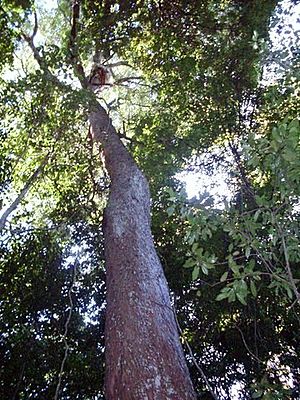Magenta lilly pilly facts for kids
Quick facts for kids Magenta lilly pilly |
|
|---|---|
 |
|
| Large specimen, trunk diameter 88 cm, estimated height 30 m, Illawarra, Australia | |
| Conservation status | |
| Scientific classification | |
| Genus: |
Syzygium
|
| Species: |
paniculatum
|
| Synonyms | |
|
|
Syzygium paniculatum, also known as the magenta lilly pilly or magenta cherry, is a type of flowering plant. It belongs to the myrtle family called Myrtaceae. This plant is originally from New South Wales, Australia.
It grows as a broad, dense, and bushy rainforest tree. When grown in gardens, it can reach about 15 meters (49 feet) tall. Its trunk can grow up to 35 centimeters (14 inches) wide. The biggest known tree of this kind is found at Ourimbah Creek, standing about 35 meters (115 feet) tall.
The leaves of the magenta lilly pilly are about 3 to 9 centimeters (1.2 to 3.5 inches) long. They grow in pairs opposite each other and are simple in shape. They are dark, shiny green on top and lighter underneath. The tree produces white flowers in clusters. Its fruit is edible and usually a bright magenta color. However, it can also be white, pink, or purple.
Contents
About the Magenta Lilly Pilly
A group of Syzygium paniculatum trees can be found on the eastern side of Jervis Bay. Some of these trees are very tall, reaching 20 to 30 meters (66 to 98 feet). Some also have very wide trunks, up to 1.5 meters (5 feet) across.
Where Does It Grow?
This tree is often grown in eastern Australia and other places around the world. It's a popular plant for gardens and parks.
Can You Eat It?
The fruit of the magenta lilly pilly is well-known as an edible wild fruit. It has a pleasant, slightly sour taste, similar to an apple. People enjoy eating it fresh. It is also often cooked to make delicious jams.
Historical Facts
In 1889, a book called 'The Useful Native Plants of Australia' mentioned this plant. It said that a similar plant, Eugenia myrtifolia, was also called "brush cherry" or "native myrtle." The book noted that the red juice from the fruit was used in ways similar to red grapes. It contained natural acids and sugars.
Similar Plants
Syzygium paniculatum is sometimes mixed up with another plant called Syzygium australe. That plant is also known as the brush cherry.
Gallery
See also
 In Spanish: Cereza magenta para niños
In Spanish: Cereza magenta para niños





